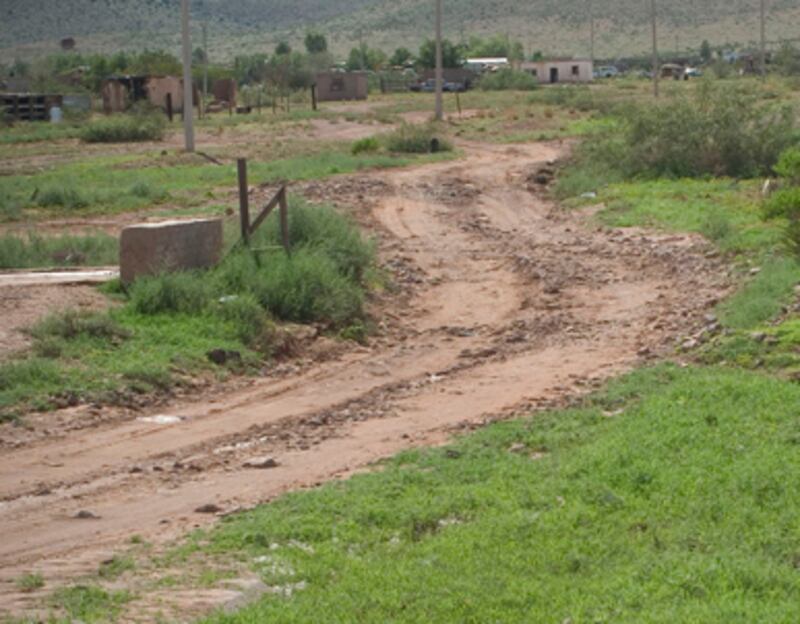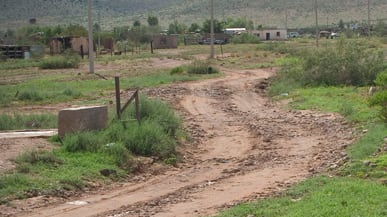A boy can't get to school because of crumbling roads and sewage. Eliza Griswold reports on why the landscape at home looks like a war-torn country.
E.J. Montoya, 16, has the well-muscled shoulders of a football player and a glossy, black braid down his back. He is a member of the Santa Ana Pueblo, one of the 22 tribes in New Mexico. On the reservation, Montoya lives with his mother and older brother in a trailer at the end of a rough dirt track about 30 miles north of the city of Albuquerque.
Waking at 6 am to make the 2 to 3 hour commute to school, Montoya peels a pair of headphones blasting heavy metal from his ears. He sleeps to the blare of Rush to drown out the sounds of his brother, a 20-year old high school drop out, and his friends who party all night in Montoya's room, which they call "the man's den."

If it's not raining so hard that the dirt road he lives on is impassable; and if his mother's white sedan is running on this morning; and if she has gas money, plus two dollars to give E.J for the rail runner train and a city bus; then Montoya can make the two-hour trip to school.
Montoya's short life story is the unsung tale of America's crumbling infrastructure—bridges, roads, drinking water, sewage lines, and the list goes on. Essentially, everything we rely on to move through our daily lives, and never stop to consider—until it breaks down.
In the next five years, the American Society of Civil Engineers estimates that the United States will have to spend more than one trillion dollars simply to sustain what we already have.
On Indian reservations, the situation is even direr. The state of New Mexico estimates it needs one billion dollars to address such everyday concerns as the lack of clean water, sewers, good roads, and electricity.
“The federal government has a Trust Responsibility to Native American tribes and their members and state governments have an obligation to provide services and resources to all of their citizens, including Native Americans who live on and off tribal lands,” New Mexico’s Indian Affairs Cabinet Secretary Alvin Warren said. "That means that the government is responsible for projects like supplying running water and electricity to reservations." There have been some heartening advances, Warren notes, including the $142 Million that has been provided to tribal communities since 2003 for infrastructure through the New Mexico Indian Affairs Department, including $25 million through the innovative Tribal Infrastructure Fund. Yet the problem is far from solved. Some tribal communities still lack basic infrastructure. Roads, running water, lights--these are some of the most pressing problems.
It would seem that infrastructure could be a pretty remote subject for a teenager, but mention it to Montoya, and he'll provide an immediate list of obstacles from bad roads to ruined buildings that keep him from getting to school. On his reservation, the most dangerous place is the broken down public pool. "Grown-ups take kids down there to get them drunk," Montoya said. His solution: "Either fix it, or blow it up."
"Kids do drugs because they have nothing to do," he said. Basketball, baseball, soccer, he plays every sport and signs up for any after-school activity to stay off the reservation for as long as possible. "Being busy keeps me out of trouble," Montoya said one recent evening when I drove him home from school.
We were parked outside his trailer in a rented white SUV. Around us in the darkness: a broken baby carriage, a rattletrap Volvo sedan, an anonymous pile of junk littered on the bare ground. I've seen this kind of chaos in refugee camps in Eastern Congo and gypsy settlements in Rome, but not in America.
I've seen this kind of chaos in refugee camps in Eastern Congo and gypsy settlements in Rome, but not in America.
Of all he does, Montoya is most proud of the care he has taken of at least nine of his dogs—Brian, Zoe, Waffles and Waffles, among others. He is proud they have died "of natural causes," that none have wandered onto the rushing highway nearby and been killed.
He surveyed the yard with a survivor's gaze. "School is my family," he said. Montoya is a tenth grader at Native American Community Academy, a cutting edge charter school for nearly four hundred Indian kids. School, he believed, was the only thing keeping him from becoming a drop out and drug addict, or worse.
Native American kids between the ages of 15 and 24 are nearly four times as likely to commit suicide as others, according to the Department of Health and Human Services. Several factors contribute to these staggering rates—failing schools, no jobs, isolation on reservations or inner cities.
“Family challenges and poverty as well as the lack of educational opportunities, youth programs and recreational facilities are among many factors that contribute to the high suicide rates in Indian Country.”
Montoya's cutting-edge school, Native American Community Academy, is an innovative effort to break that cycle of isolation. Several years ago, its founder and principal, Kara Bobroff decided to start a charter school. For the first time in history, she brought together the University of New Mexico and the public school system to service Native American kids. With 400 students from sixth to twelfth grade, NACA is now bursting from the pressed metal seams of the temporary buildings called portables.
The school is essentially a cluster of 27 portables sitting on a gravel lot in a neighborhood of downtown Albuquerque known as the "International District." Inside the chain link fence, the students had planted a small garden of tomatoes and healing herbs they were learning about. A larger garden had just been razed to make room for a larger trailer. There was a charred stump left where once the kids had made a painted pole for ceremonies. One night, it simply vanished—cut down either by vandals or by cold neighbors who could have chopped it up for firewood.
This site is supposed to be temporary. And Bobroff has raised $12.6 million dollars to break ground on the site where her school is supposed to be standing. Yet, due largely to red tape, construction has yet to begin. So her students are stuck in portables. For obvious reasons, winter poses a particular challenge.
For these students, who are used to feeling like second-class citizens, going to school in portables is demoralizing. What makes it worse is that their portables are parked next door to a neighboring public school. Since NACA has no gym, no cafeteria, no basketball court, no library, they have to ask to borrow them for dances or games from the school next door. This, too, has led to trouble. Last year, Montoya nearly got in a fight during lunch at the school next door.
"One kid killed called me a dirty, little Indian," he said. The insult was unremarkable, he explained, most kids at NACA are used to such taunts from their old schools.
As a makeshift solution, Bobroff has wrangled a way to serve hot breakfast and lunch at NACA by using the scant budget to hire an outside cook, and teaching kids about eating healthy food as part of the curriculum.
This winter, as the snow falls, these kids will either sit at lunch tables in the snow, or cram into makeshift cafeteria classrooms to eat, what is for many, their only two meals of the day.
Eliza Griswold, a Senior fellow at the New America Foundation, is the author of the New York Times bestseller The Tenth Parallel






